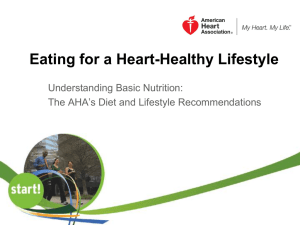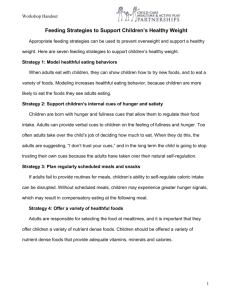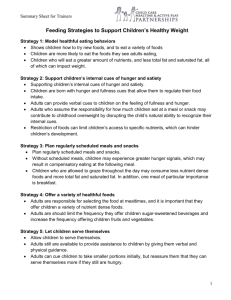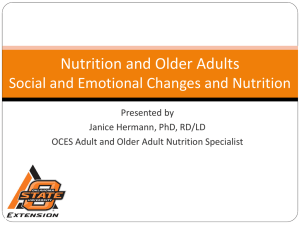File - Catherine Olsen
advertisement
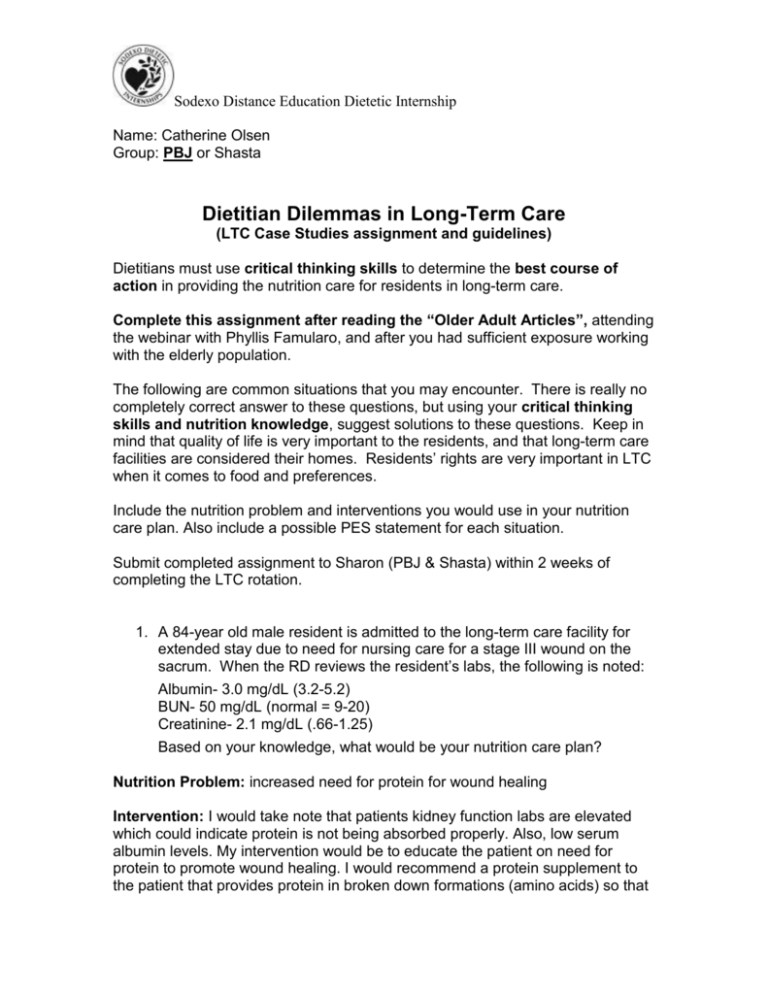
Sodexo Distance Education Dietetic Internship Name: Catherine Olsen Group: PBJ or Shasta Dietitian Dilemmas in Long-Term Care (LTC Case Studies assignment and guidelines) Dietitians must use critical thinking skills to determine the best course of action in providing the nutrition care for residents in long-term care. Complete this assignment after reading the “Older Adult Articles”, attending the webinar with Phyllis Famularo, and after you had sufficient exposure working with the elderly population. The following are common situations that you may encounter. There is really no completely correct answer to these questions, but using your critical thinking skills and nutrition knowledge, suggest solutions to these questions. Keep in mind that quality of life is very important to the residents, and that long-term care facilities are considered their homes. Residents’ rights are very important in LTC when it comes to food and preferences. Include the nutrition problem and interventions you would use in your nutrition care plan. Also include a possible PES statement for each situation. Submit completed assignment to Sharon (PBJ & Shasta) within 2 weeks of completing the LTC rotation. 1. A 84-year old male resident is admitted to the long-term care facility for extended stay due to need for nursing care for a stage III wound on the sacrum. When the RD reviews the resident’s labs, the following is noted: Albumin- 3.0 mg/dL (3.2-5.2) BUN- 50 mg/dL (normal = 9-20) Creatinine- 2.1 mg/dL (.66-1.25) Based on your knowledge, what would be your nutrition care plan? Nutrition Problem: increased need for protein for wound healing Intervention: I would take note that patients kidney function labs are elevated which could indicate protein is not being absorbed properly. Also, low serum albumin levels. My intervention would be to educate the patient on need for protein to promote wound healing. I would recommend a protein supplement to the patient that provides protein in broken down formations (amino acids) so that kidneys do not have to work too hard. I would be recommending either Beneprotein or Arginaid. PES: Increased nutrient needs related to increased demand for protein for wound healing as evidenced by stage III wound on sacrum, low serum albumin level of 3.0. 2. When conducting meal rounds, you observe a resident spitting out pieces of food. What are the possible causes and what interventions could you try to address this concern? Nutrition Problem: Inadequate oral intake, pt spitting out food Intervention: Talk to pt about why they are spitting out their food. Possible causes of this could be difficulty swallowing, ill fitting dentures making chewing difficult, no/missing teeth making chewing difficult, and dislike for foods offered. Depending on the reason for the patient spitting out the food, I would provide a different intervention. If the patient was having difficulty swallowing, I would get speech therapy involved for a swallow evaluation. If pts dentures were too big/small, or if they had no/missing teeth, I would get social work involved to see if we could get better fitting dentures or a new pair if resident hadn’t had them before. I would also educate pt on softer foods and taking smaller bites for less difficulties/irritation. Lastly, if pt simply had dislike for food offered at LTC site, I would help pt identify items on menu he might enjoy and provide him with some seasoning ideas for making foods taste more appealing to him. PES: Inadequate oral intake related to biting/chewing difficulty as evidenced by pt observed spitting out food, pt reports dentures to be too big. 3. A 73 year-old obese female resident with a BMI of 38 and a diagnosis of diabetes enters your LTC community with a stage II pressure wound on her heel. Her albumin level is 2.4 mg/dL. What interventions could be part of your nutrition care plan? Nutrition Problem: increased demand for protein for wound healing. Intervention: My goal would be to try and get her to agree to order protein foods with every meal. If that does not work, I would discuss with MD possibly adding a supplement that is high in protein such as Beneprotein, Arginaid, or even a DM Boost/Ensure. I would plan to educate the resident on the carbohydrate counting diet using one of the menus from the LTC facility so that she can see options on the menu that would be appropriate for her. Since her albumin level is low at 2.4 mg/dL and due to the stage II pressure wound, I would discuss the importance high protein and good blood glucose control for her pressure wound to heal properly. I would explain that protein, unless breaded, has no carbohydrates so she wouldn’t have to add it to her carbohydrate-counting. PES: Inadequate oral intake related to excessive carbohydrate intake, less than optimal protein intake as evidence by new DM diagnosis, albumin of 2.4 mg/dL, nonhealing stage II pressure wound on heel. 4. A resident with mild dysphagia is admitted to your LTC community. After being seen by the speech therapist, the resident is placed on a pureed diet with nectar thick liquids. You observe the resident eating poorly at meals and “sneaking” thin liquids from the hydration cart (a cart on the resident’s unit to get water, juice, etc.). What course of action should you take? Nutrition Problem: inadequate oral intake/difficulty swallowing Intervention: First, I would notify the nursing staff of what I observed the patient doing. Then I would talk with patient about the dangers of drinking thin liquids for the risk of aspiration. I would ask him why he is spitting out his food; if he says that he doesn’t like the food that consistency, I will talk to him about foods that aren’t necessarily pureed but fit on his diet, such as mashed potatoes. I would also discuss with patient possibly starting him on a supplement that fits the nectar thick liquid requirement, such as Magic Cup. I would be afraid that the patient is not getting enough calories po and that hopefully a supplement will help. If both those attempts fail, I would recommend NG tube feedings at a low rate at night getting in some calories and resident can continue to try to get calories in po. If that attempt fails then enteral nutrition would become the residents route of nutrition. PES: Inadequate oral intake related to difficulty swallowing as evidenced by patient swallow evaluation requiring altered food consistency, observed pt spit out food OR Inadequate energy intake related to pts dislike for diet order as evidenced by pt spitting out food, observed pt sneaking thin liquids 5. You have assessed a new resident with a poor appetite and weight loss prior to admission. Your recommended interventions are to add fortified foods (added protein and calories provided via fortified foods, such as “Super Cereal”, enhanced mashed potatoes, etc.), a milkshake for a 2pm snack as well as a multivitamin with minerals. You leave a recommendation for the physician to add the multivitamin with minerals; however, the physician refuses your recommendation. What would you do? Nutrition Problem: MD refused MVI and fortified food recommendations made in previous assessment Intervention: I would talk with MD and see his plan of care for this patient. I would express my concerns for poor po intake and weight loss and see what MD recommends. If MD still denies my recommendations, I would educate patient on ordering small and frequent meals that are high in calories and protein. I would educate pt on foods high in protein and ways to “beef up” foods to have more calories (ie add whole milk, butter, etc). PES: Predicted suboptimal energy intake related to decreased ability to consume sufficient energy as evidenced by history of suboptimal intake, history of recent weight loss. ** I chose this PES statement because I have not observed this weight loss/poor appetite upon this new admission to LTC site. If after some time weight loss is observed and continued poor appetite, I would use “inadequate oral intake” or “inadequate energy intake” or “unintended weight loss”. 6. A family member of a resident informs you that a resident is to have a very low sodium diet due to a history of hypertension. The resident is alert and oriented and informs you during your visit that they love hot dogs. What would be your course of action? Nutrition Problem: Unsure of pts therapeutic diet needs Intervention: I would not necessarily just listen to the pts family member, I would look back on old records and contact patients’ general physician. If through some investigating I learn that pt actually does need a very low sodium diet d/t history of HTN, I would then educate the pt and family about this dietary restriction, how to read food labels and food items higher in sodium, and educate on not using the salt shaker at the table. I would make sure diet office/dining center was aware of pts dietary restriction and was able to accommodate for his needs. Would also advice dietary aids/RNs to observe and be sure he is not adding additional salt to foods at table/bedside. PES: Food and nutrition knowledge related deficit related to no prior nutritionrelated education as evidenced by pt unable to tell RD of his dietary restriction, pt unable to name foods high in sodium. QUALITY ASSESSMENT CRITERIA ____ Answers to questions are expressed clearly, and thoughtfully ____Answers are based on evidence based nutrition practices ____ Summary paragraphs are clear and succinct ____Assignment is submitted on time, within 2 weeks of the completion of the rotation Put the FUN in Fungibility: Below are some skills you will learn with this assignment that can be transferred to any area of practice: Assessment *** Research *** Organization *** Cultural Competence Writing *** Evaluation *** Critical Thinking

